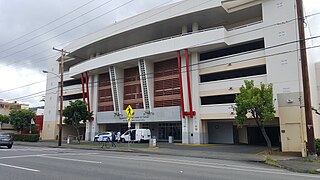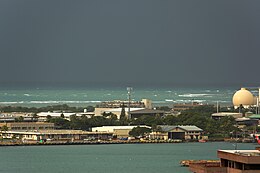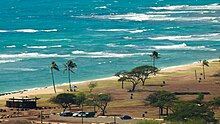
Honolulu is the capital and most populous city of the U.S. state of Hawaii, which is in the Pacific Ocean. It is the unincorporated county seat of the consolidated City and County of Honolulu, situated along the southeast coast of the island of Oʻahu, and is the westernmost and southernmost major U.S. city. Honolulu is Hawaii's main gateway to the world. It is also a major hub for business, finance, hospitality, and military defense in both the state and Oceania. The city is characterized by a mix of various Asian, Western, and Pacific cultures, reflected in its diverse demography, cuisine, and traditions.

During World War II, the United States forcibly relocated and incarcerated at least 125,284 people of Japanese descent in 75 identified incarceration sites. Most lived on the Pacific Coast, in concentration camps in the western interior of the country. Approximately two-thirds of the inmates were United States citizens. These actions were initiated by president Franklin D. Roosevelt via an executive order shortly after Imperial Japan's attack on Pearl Harbor.

Waikiki is a neighborhood of Honolulu on the south shore of the island of Oʻahu in the U.S. state of Hawaii.

Kapolei is a planned community in Honolulu County, Hawaiʻi, United States, on the island of Oʻahu. It is colloquially known as the "second city" of Oʻahu, in relation to Honolulu. For statistical purposes, the United States Census Bureau has defined Kapolei as a census-designated place (CDP) within the consolidated city-county of Honolulu.

Ala Moana Beach Park is a free public park on the island of Oahu, U.S. state of Hawaii, located between Waikiki and downtown Honolulu. This 100-acre (0.40 km2) park has a wide gold-sand beach that is over a half-mile long.

The Topaz War Relocation Center, also known as the Central Utah Relocation Center (Topaz) and briefly as the Abraham Relocation Center, was an American concentration camp that housed Americans of Japanese descent and immigrants who had come to the United States from Japan, called Nikkei. President Franklin Roosevelt signed Executive Order 9066 in February 1942, ordering people of Japanese ancestry to be incarcerated in what were euphemistically called "relocation centers" like Topaz during World War II. Most of the people incarcerated at Topaz came from the Tanforan Assembly Center and previously lived in the San Francisco Bay Area. The camp was opened in September 1942 and closed in October 1945.

Go! was a regional brand of Arizona-based Mesa Airlines. Go! operated inter-island services within Hawaii. Its main base was Honolulu International Airport. It was a division within the Mesa Airlines subsidiary of Mesa Air Group and its flights were operated by Mesa Airlines. The airline ceased operations in Hawaii on April 1, 2014. The company slogan was Hawaii's Low Fare Airline.

The Poston Internment Camp, located in Yuma County in southwestern Arizona, was the largest of the 10 American concentration camps operated by the War Relocation Authority during World War II.

Internment of German resident aliens and German-American citizens occurred in the United States during the periods of World War I and World War II. During World War II, the legal basis for this detention was under Presidential Proclamation 2526, made by President Franklin Delano Roosevelt under the authority of the Alien Enemies Act.

Honolulu County is a consolidated city-county in the U.S. state of Hawaii. The city-county includes both the city of Honolulu and the rest of the island of Oʻahu, as well as several minor outlying islands, including all of the Northwestern Hawaiian Islands except Midway Atoll.

Crystal City Internment Camp, located near Crystal City, Texas, was a place of confinement for people of Japanese, German, and Italian descent during World War II, and has been variously described as a detention facility or a concentration camp. The camp, which was originally designed to hold 3,500 people, opened in December 1943 and was officially closed on February 11, 1948.
Honouliuli National Historic Site is near Waipahu on the island of Oahu, in the U.S. state of Hawaii. This is the site of the Honouliuli Internment Camp which was Hawaiʻi's largest and longest-operating internment camp, opened in 1943 and closed in 1946. It was designated a National monument on February 24, 2015, by President Barack Obama. The John D. Dingell, Jr. Conservation, Management, and Recreation Act, signed March 12, 2019, redesignated it as Honouliui National Historic Site. The internment camp held 320 internees and also became the largest prisoner of war camp in Hawaiʻi with nearly 4,000 individuals being held. Of the seventeen sites that were associated with the history of internment in Hawaiʻi during World War II, the camp was the only one built specifically for prolonged detention. As of 2015, the new national monument is without formal services and programs.
Sanji Abe was a pre-World War II politician in Hawaii. He was the first Japanese American elected to the Senate of the Territory of Hawaii.

The Chinatown Historic District is a neighborhood of Honolulu, Hawaii, known for its Chinese American community. It is one of the oldest Chinatowns in the United States.

The Honolulu Star-Advertiser is the largest daily newspaper in Hawaii, formed in 2010 with the merger of The Honolulu Advertiser and the Honolulu Star-Bulletin after the acquisition of the former by Black Press, which already owned the latter.

The Japanese Cultural Center of Hawaii is a cultural center and history museum in Moiliili, Hawaii that focuses on the Japanese-American experience in Hawaii, especially internment.
Kumaji Furuya(古屋熊次)(February 22, 1899 – November 4, 1977) was a Japanese businessman who worked in Hawaii. He started the Fuji Furniture store in Aala, and created Hawaii's first Japanese-language radio program. His penname was Suikei(翠溪).
Tokiji "Sojin" Takei (April 6, 1903 – July 23, 1991) was a Japanese poet and essayist who lived in Hawaii. He was a prolific writer who is best known for his poetry written while he was incarcerated in a series of internment camps.
Chinyei Kinjo (金城珍栄)(December 21, 1899 – March 3, 1987) was an Okinawan journalist. He ran the Yoen jiho for most of its 49-year history.

Naval Base Hawaii was a number of United States Navy bases in the Territory of Hawaii during World War II. At the start of the war, much of the Hawaiian Islands was converted from tourism to a United States Armed Forces base. With the loss of US Naval Base Philippines in Philippines campaign of 1941 and 1942, Hawaii became the US Navy's main base for the early part of the island-hopping Pacific War against Empire of Japan. Naval Station Pearl Harbor was founded in 1899 with the annexation of Hawaii.

















